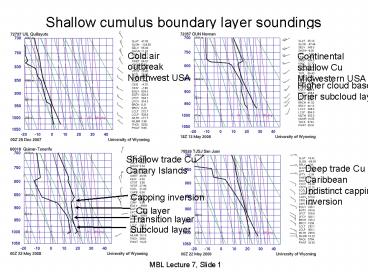Shallow cumulus boundary layer soundings - PowerPoint PPT Presentation
1 / 8
Title:
Shallow cumulus boundary layer soundings
Description:
Canary Islands. Deep trade Cu. Caribbean. Subcloud layer. Transition layer. Cu layer ... Cumuli have a uniform base marking the top of a turbulent subcloud ... – PowerPoint PPT presentation
Number of Views:27
Avg rating:3.0/5.0
Title: Shallow cumulus boundary layer soundings
1
Shallow cumulus boundary layer soundings
Cold air outbreak Northwest USA
Continental shallow Cu Midwestern USA
Higher cloud base Drier subcloud layer
Shallow trade Cu Canary Islands
Deep trade Cu Caribbean
Indistinct capping inversion
Capping inversion
Cu layer
Transition layer
Subcloud layer
2
Shallow Cu ensemble characteristics
- Cumuli have a uniform base marking the top of a
turbulent subcloud mixed layer. - Individual cumuli are complex mixtures of
updrafts and downdrafts that vigorously entrain
surrounding air. - Entrainment evaporates and cools the cloudy
updrafts.
Warner 1955
3
Air parcel circuits in a trade cumulus layer
Bretherton 1997
4
LES view of shallow Cu ensemble (BOMEX Siebesma
and Cuijpers 1995)Dx 100 m, Dz 40 m, Lx Ly
6.4 km
(dq/dt)adv - 1 g/kg-d Wmin -0.65 cm/s Qr -2
K/d
5
Conditionally-sampled LES shallow cumulus clouds
(GCSS BOMEX case, Siebesma et al. 2003)
Overshooting Cu
Clouds are barely buoyant. 50 of cloud
non-buoyant Even cores (buoyant cloud) are
diluted, not very buoyant.
Bottom-heavy cloud population All LES models
closely agree.
6
Humidity and humidity-based entrainment
Core bulk lateral entrainment rate e 1-2
km-1 inferred from e dqt,co/dz /(qt,co -
qt). Cu cores entrain vigorously
7
Cu updraft velocity and liquid water content
Shallow Cu with more updraft liquid water or few
condensation nucleii can rain heavily.
8
Vertical transport
Cu mass flux
momentum flux
bottom-heavy only biggest Cu reach into trade
inversion
Mass flux
surface drag spread over lowest km
Upward Cu flux of x
wind
Flux convergence
buoyancy flux
moisture flux
cumuli
Entrained air moistened and evaporatively cooled
transition layer
surface driving






























